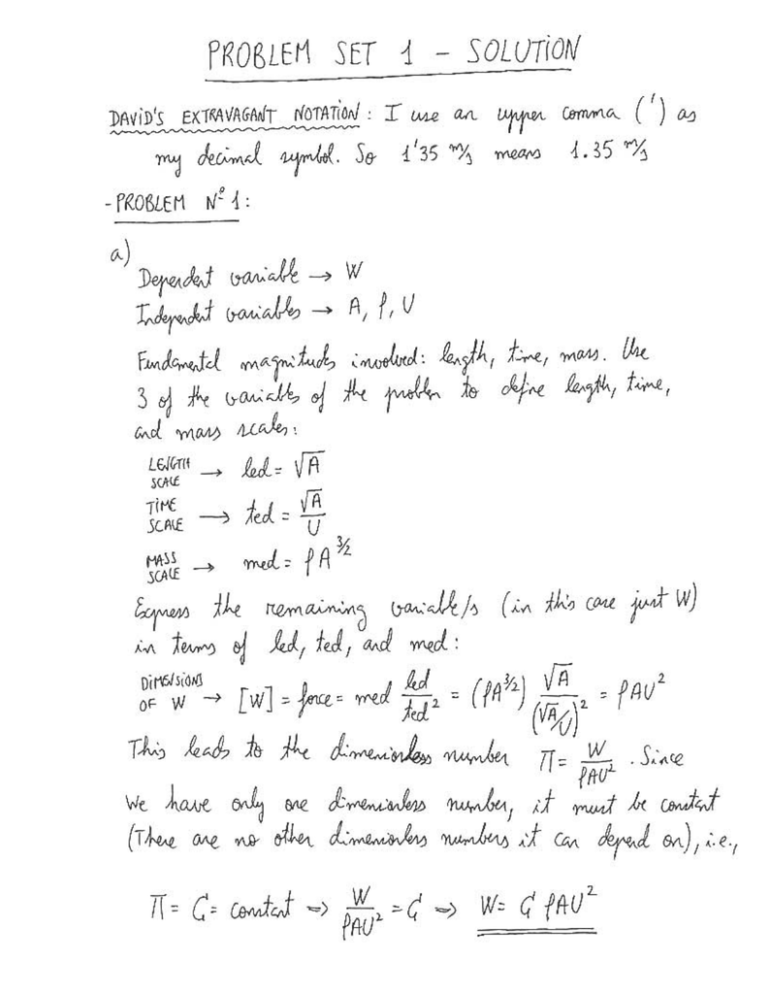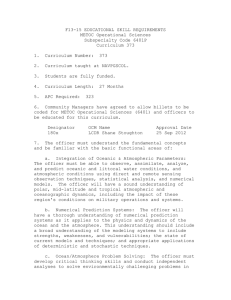Document 13491578
advertisement

Comments about Problem Set 1 PROBLEM 1: - There were many different answers to part (c). Some groups argued that the reason for the unexpected ability of Asafa Powell to run on water was that Asafa and the lizard have a different ratio of weight (W) to feet sole area (A) (since the area increases with L2 and the weight with L3). This argument is not correct: Both parameters W and A have been included in the analysis, and therefore it doesn’t matter if their ratio changes. The key to part (c) was thinking of which variables had not been included in the analysis. PROBLEM 2: - Some groups stated that the absolute pressure at point A is equal to atmospheric. This is not true: the absolute pressure in the fluid is atmospheric 10 meters below A, so the absolute pressure in A is smaller than atmospheric. How can this be possible if the pressure of the air slightly above A is atmospheric? This is due to surface tension effects. The surface tension introduces a force on the surface of the fluid, which causes a discontinuity between the pressure in the air and the pressure in the fluid below the surface. So why do we usually take pabs=patm at the surface of a body of water in contact with the atmosphere? Because surface tension effects are only relevant very close to the surface boundaries, and we usually have a free surface of a size much larger than the cross-section of a capillary tube. - Remember that 1kN = 1000 N, and 1 N = 0.001 kN. For some reason, some people got confused with this twice in the problem, and obtained a tube diameter 1 million times larger than the correct one (which you should notice!). Be careful when converting units. The numerical value must become smaller (1 to 0.001) when the unit in which you measure becomes larger (N to kN). PROBLEM 3: - Many of you seemed confused about the meaning of the accuracy of an estimate. When you have a series of measurements of an unknown parameter (µ in this problem), your best estimate of the true value is the mean, and the accuracy is given in terms of the standard deviation. Assuming the error to be normally distributed (which is generally the case), the most precise way of giving the value of the unknown parameter is as (value of the parameter) = (mean) ± 2*(standard deviation) where 2*(standard deviation) is the accuracy of the estimate. Due to the properties of the normal distribution, you can be 95% sure that the true value of the parameter will be within ± 2 standard deviations about the mean. GENERAL COMMENTS: - In general, we think that you give too little information about how you resolve the problems. It is not enough to write some equations; you need to show the details of your work and explain in words what you are doing. Along the same lines, please avoid giving a numerical answer without an explanation of where it comes from. If you don’t show your calculations and your numerical answer is wrong, you’ll most likely get 0 points in that part. Even if your numerical answer is right, you probably won’t get full score, since you are not proving that you know how to do the problem. This also applies to solutions obtained with a spreadsheet (which some people used in problem 3): Show sample calculations, not just a print with the numerical answer! When the answer is qualitative, you also need to explain how you came up with it. For instance, in the centrifuge problem, some groups wrote that the cream ends up at the center, on top of the milk, without any explanation of why this is the case. This is considered an incomplete answer. - Whenever possible, don’t stop working at the numerical answer or final analytical expression. Instead, you can do a number of things to explore the meaning of your result: ● Explain the implications of the result: How does it answer to the question asked in the problem? (E.g., in problem three, part c, some people wrote down the value of the standard deviation… without commenting how it relates to the accuracy of the estimate). ● Check that your solution is dimensionally correct. If your answer is an analytical expression, check that the dimensions of the left and right hand sides are the same. If it is a number, check that the units match the magnitude you are calculating (i.e., a pressure must be in Pa or another pressure unit). ● If it is a numerical answer, comment about its magnitude. Is it big or small? Is it a reasonable value? Did you expect a result of that order of magnitude? (E.g., in problem 2, some people got a diameter of 3 meters… Even if you don’t find any mistake in your calculations, you should realize that such a result is unreasonably big and comment about it). ● If your answer is an analytical expression, comment whether the dependencies between variables make sense. (For instance, in problem 3, we expect ω to increase with the applied torque, so it would be surprising if ω appeared in the denominator of the right hand side of the expression). ● If your answer is an analytical expression, you may be able to analyze particular cases and see if the result makes sense. (E.g., in the centrigufe problem, check for a horizontal surface when ω = 0). ● Represent your solution graphically whenever possible. If it is a vector, plot it. If it is a function, represent it in an x-y diagram or similar. (For instance, represent the free surface in the centrifuge problem) This kind of analysis will give you insight into the solution. From the grader’s point of view, it will be clear that you understand the meaning of your answer (so you may even get some bonus points!).


